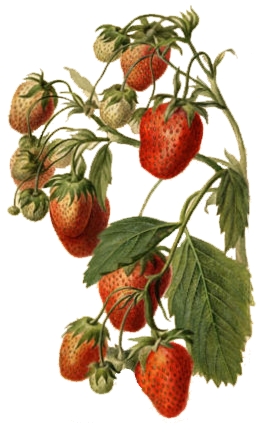Outline of strawberries
Overview of and topical guide to strawberries
The following outline is provided as an overview of and topical guide to strawberries:
Strawberries[edit | edit source]
Strawberries are widely appreciated for their characteristic aroma, bright red color, juicy texture, and sweetness. They are consumed in large quantities, either fresh or in prepared foods such as preserves, fruit juice, pies, ice creams, milkshakes, and chocolates. Artificial strawberry flavorings and aromas are also widely used in many products like lip gloss, candy, hand sanitizers, perfume, and many others.
Characteristics[edit | edit source]
- Botanical name: The strawberry belongs to the genus Fragaria within the family Rosaceae.
- Fruit type: Botanically, the strawberry is an aggregate accessory fruit, meaning the fleshy part is derived not from the plant's ovaries but from the receptacle that holds the ovaries.
- Cultivation: Strawberries are grown in a variety of climates and are cultivated worldwide for their fruit.
Varieties[edit | edit source]
- Garden strawberry (Fragaria × ananassa): The most common type of strawberry cultivated worldwide.
- Wild strawberry (Fragaria vesca): Known for its intense flavor and aroma.
- Pineberry: A white strawberry cultivar with a pineapple-like flavor.
Uses[edit | edit source]
- Culinary: Strawberries are used in a variety of culinary applications, including desserts, salads, and beverages.
- Nutritional: Strawberries are rich in vitamin C, manganese, folate, and potassium.
- Medicinal: Historically, strawberries have been used in herbal medicine for their anti-inflammatory properties.
Strawberry Cultivation[edit | edit source]
Strawberry cultivation involves several key practices to ensure healthy growth and fruit production.
Planting[edit | edit source]
- Soil preparation: Strawberries prefer well-drained, sandy loam soil with a pH between 5.5 and 6.8.
- Spacing: Plants should be spaced 12 to 18 inches apart to allow for adequate air circulation and growth.
Care[edit | edit source]
- Watering: Regular watering is essential, especially during dry periods, to maintain soil moisture.
- Fertilization: Balanced fertilizers are recommended to promote healthy growth and fruiting.
Pests and Diseases[edit | edit source]
- Common pests: Include aphids, spider mites, and slugs.
- Diseases: Such as powdery mildew, gray mold, and verticillium wilt can affect strawberry plants.
Strawberry Varieties[edit | edit source]
Notable Cultivars[edit | edit source]
- 'Pink Panda': Known for its ornamental value and pink flowers.
- 'Fragaria daltoniana': A species of strawberry native to the Himalayas.
Hybrid Varieties[edit | edit source]
- Day-neutral varieties: Produce fruit throughout the growing season.
- June-bearing varieties: Produce a single large crop in early summer.
Strawberry Products[edit | edit source]
Strawberries are used to make a variety of products, both fresh and processed.
Fresh Products[edit | edit source]
- Strawberry shortcake: A popular dessert made with strawberries, cream, and cake.
Processed Products[edit | edit source]
- Jams and preserves: Strawberries are commonly used in making jams and preserves.
- Beverages: Strawberry juice and smoothies are popular drinks.
Strawberry Festivals[edit | edit source]
Strawberry festivals are held in many regions to celebrate the harvest and enjoy strawberry-themed activities and foods.
Related Pages[edit | edit source]
Search WikiMD
Ad.Tired of being Overweight? Try W8MD's physician weight loss program.
Semaglutide (Ozempic / Wegovy and Tirzepatide (Mounjaro / Zepbound) available.
Advertise on WikiMD
|
WikiMD's Wellness Encyclopedia |
| Let Food Be Thy Medicine Medicine Thy Food - Hippocrates |
Translate this page: - East Asian
中文,
日本,
한국어,
South Asian
हिन्दी,
தமிழ்,
తెలుగు,
Urdu,
ಕನ್ನಡ,
Southeast Asian
Indonesian,
Vietnamese,
Thai,
မြန်မာဘာသာ,
বাংলা
European
español,
Deutsch,
français,
Greek,
português do Brasil,
polski,
română,
русский,
Nederlands,
norsk,
svenska,
suomi,
Italian
Middle Eastern & African
عربى,
Turkish,
Persian,
Hebrew,
Afrikaans,
isiZulu,
Kiswahili,
Other
Bulgarian,
Hungarian,
Czech,
Swedish,
മലയാളം,
मराठी,
ਪੰਜਾਬੀ,
ગુજરાતી,
Portuguese,
Ukrainian
Medical Disclaimer: WikiMD is not a substitute for professional medical advice. The information on WikiMD is provided as an information resource only, may be incorrect, outdated or misleading, and is not to be used or relied on for any diagnostic or treatment purposes. Please consult your health care provider before making any healthcare decisions or for guidance about a specific medical condition. WikiMD expressly disclaims responsibility, and shall have no liability, for any damages, loss, injury, or liability whatsoever suffered as a result of your reliance on the information contained in this site. By visiting this site you agree to the foregoing terms and conditions, which may from time to time be changed or supplemented by WikiMD. If you do not agree to the foregoing terms and conditions, you should not enter or use this site. See full disclaimer.
Credits:Most images are courtesy of Wikimedia commons, and templates, categories Wikipedia, licensed under CC BY SA or similar.
Contributors: Prab R. Tumpati, MD





